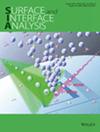Depth profile study of LaAl1‐xCrxO3/SrTiO3 (x = 0, 0.2, 0.6, and 1) using time of flight secondary ion mass spectrometry (TOF‐SIMS)
IF 1.8
4区 化学
Q4 CHEMISTRY, PHYSICAL
引用次数: 0
Abstract
The conducting two‐dimensional electron gas (2DEG) behavior in LaAlO利用飞行时间二次离子质谱 (TOF-SIMS) 对 LaAl1-xCrxO3/SrTiO3 (x = 0、0.2、0.6 和 1)进行深度剖面研究
LaAlO3(LAO)/SrTiO3(STO)中的导电二维电子气(2DEG)行为及其相关机制从各个方面引起了相关研究领域的极大关注。为了将 2DEG 行为与它们的组成联系起来,我们对沉积在以二氧化钛为端基的 STO(包括两种母体化合物 LAO/STO(金属)和 LCO/STO(绝缘))上的掺铬 LAO/STO 系统薄膜进行了飞行时间二次离子质谱(TOF-SIMS)深度剖面分析。LAO/STO(金属)体系界面上 La 和 Al 的浓度均匀下降,相反,LCO/STO(绝缘)体系中 La 和 Cr 的浓度则不均匀。LAO/STO 界面上离子浓度的均匀变化可能会增加职业浓度,从而使系统具有金属特性。由于铝和铬的混合,中间成分界面上的向上和向下扩散与母体不同。我们的研究结果可能有助于了解 LAO/STO 系统的导电性质,从而促进此类系统的未来开发和应用。
本文章由计算机程序翻译,如有差异,请以英文原文为准。
求助全文
约1分钟内获得全文
求助全文
来源期刊

Surface and Interface Analysis
化学-物理化学
CiteScore
3.30
自引率
5.90%
发文量
130
审稿时长
4.4 months
期刊介绍:
Surface and Interface Analysis is devoted to the publication of papers dealing with the development and application of techniques for the characterization of surfaces, interfaces and thin films. Papers dealing with standardization and quantification are particularly welcome, and also those which deal with the application of these techniques to industrial problems. Papers dealing with the purely theoretical aspects of the technique will also be considered. Review articles will be published; prior consultation with one of the Editors is advised in these cases. Papers must clearly be of scientific value in the field and will be submitted to two independent referees. Contributions must be in English and must not have been published elsewhere, and authors must agree not to communicate the same material for publication to any other journal. Authors are invited to submit their papers for publication to John Watts (UK only), Jose Sanz (Rest of Europe), John T. Grant (all non-European countries, except Japan) or R. Shimizu (Japan only).
 求助内容:
求助内容: 应助结果提醒方式:
应助结果提醒方式:


